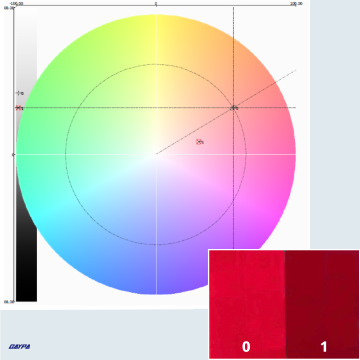
Can the delta color change between production batches?
Have you ever compared identical production pieces, but made at two different times, and found that the color is completely different? Have you ever seen two items, made from the same raw materials, present a high delta color, without being able to explain why? Don't worry. It happens even to the best ones. We will tell you the secret. Usually, in order to start an industrial production, you first need a sample as a reference point. In the case of the plastic processing world, the laboratory staff analyzes that sample and identifies its characteristic color. Once they have studied a formula to replicate the piece on a larger scale, you can proceed with the production. Then, the Quality Department verifies that the item made is as faithful as possible to the original sample. As for the color, you need to make sure that the pigment mix chosen works well, obtaining a shade like the original.
What is delta color?
The difference between colors is calculable and its unit of measurement is the delta color (Delta-E). The higher this value is, the greater the difference between shades, also defined as "chromatic distance ". Of course, in industrial production, there is a limit of tolerance because it is really difficult to replicate a color to perfection. Moreover, certain differences are almost imperceptible to the naked eye. But then, why can it happen that different batches of the same product are considerably different in shade compared to the original sample? How does color change occur when using the same raw materials?
Caption: simplified comparison of two red plastic plates. From the graph, you can notice two values: light and shade. Sample number 0 has a lighter color which tends towards orange, while sample number 1 has a darker color which tends towards magenta. To visually illustrate the concept, we chose two samples with a very high Delta-E, above the value of 30. Usually, a laboratory works on delta color values even lower than 1.

Delta color and pigments: a matter of dispersion
The color of a plastic object depends on how many and which pigments are dispersed on its surface. Differences in the concentration (i.e., amount) of pigments present can determine different shades and, consequently, a high delta color. Any mixture, to be in balance, needs each ingredient to be added only up to a certain limit, to a maximum concentration. For example, if we mix a lot of flour with just a drop of water, it will be impossible to have a good dough to make bread. The same concept also applies to pigments and additives combined with polymers. For this reason, optimal dispersion is difficult to achieve at high concentrations. One of the modern technical trends is producing more and more concentrated masterbatch. Indeed, the greater the amount of pigment available, the more coloring strength the product will have.
Color manufacturers and cunning pizza makers
Unfortunately, the path of quality and innovation is not the same as the path of ease. Nowadays, finding diluted masterbatch instead of concentrated masterbatch happens more and more often. They are just like pizzas made with an excess of water: deformed, tasteless and so thin when lifting the slice all the seasoning falls on the plate. Personally, when mozzarella and tomato slip off and only a wet flap of dough remains, I find it a real disgrace. You cannot expect to get a tasty pizza if you economize too much in its ingredients. The problem is that many pizza makers have become cunning: they reduce the ingredients bit by bit, "so the customer doesn't notice." They start by dropping the amount of flour, then the amount of mozzarella, then the size of the dough... These changes are not immediately noticeable, especially when they occur over an extended period of time. But in the end, you realize that something is wrong, because you end the meal still hungry all the time.

The color drift
Unfortunately, this also happens with colors. Falling into the concentration of the product offered means getting a mediocre end result. You don't notice it right away, because noticing certain differences in the shades of the same tone is virtually impossible for an untrained eye. And so, in the long run, the color of an item begins to degrade due to imperceptible variations. A chromatic drift is defined as the faint, but constant coloristic alteration over time, which over the long term causes variations in the delta color unit to be enormous. This is where masterbatch producers come in. The skill of the experienced masterbatch maker is to be able to produce consistently equal items, to prevent and prevent alterations, guaranteeing the customer the delivery of identical products over time with consistent concentration. No unwelcome surprises. Like mom giving your old toys to your little cousin, because you weren't using them anymore anyway, so you wouldn't even notice. But instead you did notice, all right.
Color alterations over time
Sometimes the color drift is not intentional, it just happens. The reasons can be innumerable: change of raw material suppliers, slight manufacturing errors, alteration of quality control machinery, personnel turnover... But in the end the issue remains the same: perhaps after years, you compare a printed product with the original sample found by chance in the warehouse shelves. Only at that moment, comparing the items, it turns out that (alas!) they are of two completely different colors. Is it possible that no one noticed such a high delta color before? Yet tools to check that color is within the tolerance limit exist!
Earthquakes, volcanoes, and color changes
In this case, to explain what happened, we turn to geology: the sudden eruption of a volcano with great shaking of the ground, fractures in the soil, flows of lava and ash scattered over hundreds of kilometers is an event very newsworthy. But no one pays particular attention to the brief and imperceptible movements of the earth, often underwater, which cause very slight oscillations every day. Yet, it is precisely these almost daily micro-earthquakes, constant but imperceptible, that move continents. Thus a major production error is much more evident, but paradoxically less drastic, than a slow but progressive change.
In other word, comparing the produced items only with the previous batch and not with the original sample increases the margin of error within tolerance. This is because the reference point is no longer the one established in the beginning, but one made at a second or third moment. As we have said, it is almost impossible to produce two colors perfectly equally, therefore new sample already contains a percentage of delta color alteration that can only increase between productions.

Any issue with your colors?
Have you just found out that you have an ongoing earthquake in production? Contact us!